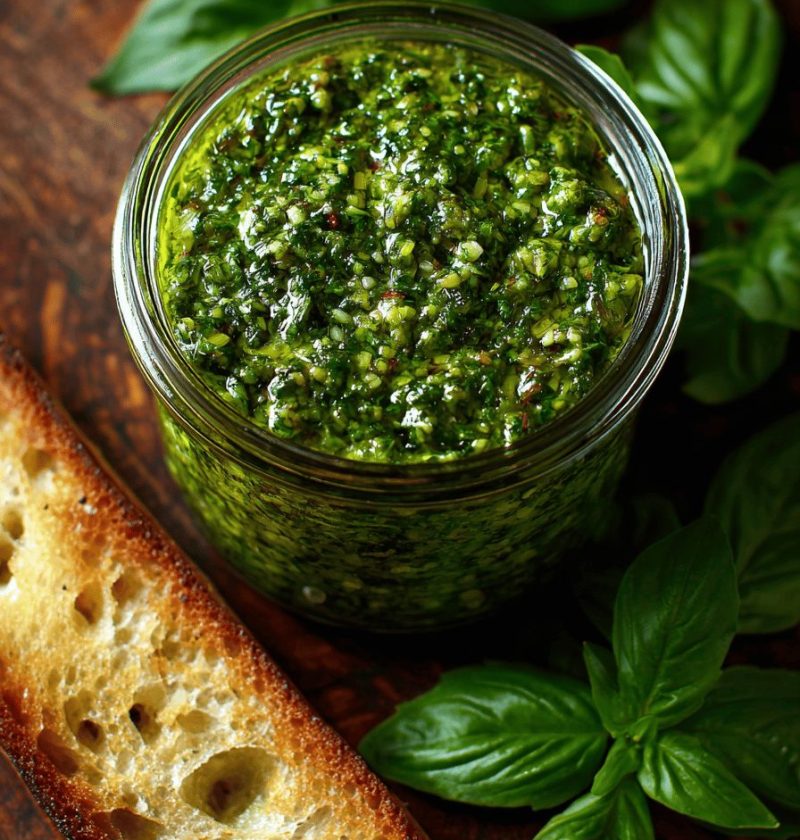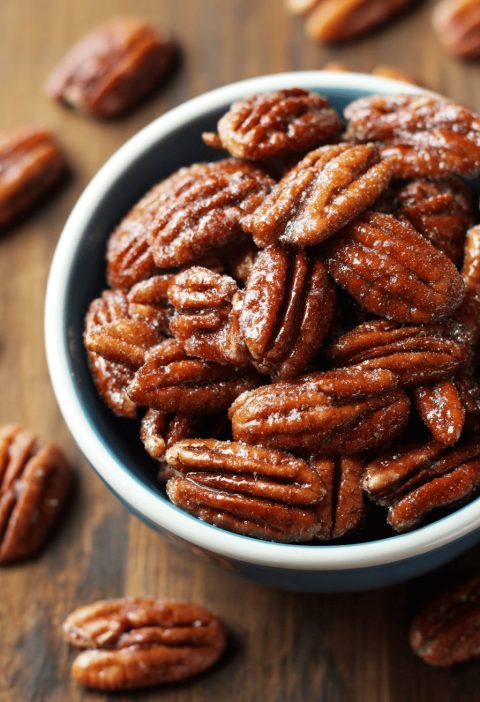Would you like to save this?
Basil Pesto Recipe
Bright, vibrant, and super easy, this homemade Basil Pesto Recipe whips up in minutes—no cooking required and overflowing with fresh ingredients for a classic Italian cuisine favorite.
This basil pesto, a traditional condiment from Liguria, Italy, brings the taste of sun-warmed gardens right to your table. It’s vegetarian, versatile, and full of aromatic herbs, nuts, garlic, and olive oil. You know what? I first made it last summer when my basil was practically taking over the windowsill. Since then, it’s been a go-to sauce for pasta nights, a spread for sandwiches, and even a quick dip for crisp veggies. It’s healthy, flavorful, and really easy—perfect for any season.
Why You’ll Love This Recipe
- Ready in under 10 minutes—no oven or stove needed.
- Uses fresh ingredients—no preservatives, just pure flavor.
- Gluten-free and vegetarian—ideal for diverse diets.
- Versatile condiment—toss with pasta, spread on bread, drizzle over salad.
- Nut-rich for extra creaminess—pine nuts or walnuts both work.
- Bold garlic punch balanced by bright olive oil.
- Makes a great gift—jar it for friends, family, or potlucks.
- Classic Italian cuisine appeal—timeless and authentic.
Ingredients
• 2 cups fresh basil leaves, packed (look for vibrant green, small-leaf basil if you can)
• ½ cup extra-virgin olive oil, plus a drizzle for topping (I love California-grown brands like California Olive Ranch)
• ⅓ cup pine nuts (or substitute toasted walnuts or almonds)
• 2 cloves garlic, roughly chopped (adjust to taste—roasted garlic adds mellow depth)
• ½ cup freshly grated Parmesan cheese (or Pecorino Romano for a sharper tang)
• ¼ teaspoon sea salt (Kosher salt works too—start small and taste)
• Freshly ground black pepper, to taste
• Juice of half a lemon (optional, for brightness)
Tip: Gently rinse basil, then pat dry completely—excess water can make the pesto watery.
Directions
- Gather your tools. You’ll need a food processor or blender—an immersion blender works in a pinch.
- Toast the nuts (optional). In a dry skillet over medium heat, shake pine nuts for 2–3 minutes until fragrant and lightly golden—watch closely so they don’t burn.
- Pulse garlic and nuts. Add chopped garlic and toasted nuts to the bowl. Pulse 5–6 times until coarsely chopped.
- Add basil and cheese. Toss in basil leaves and Parmesan, then pulse 4–5 more times until the mixture is a rough paste.
- Stream in olive oil. With the motor running, slowly pour in olive oil through the feed tube; stop when you reach silky, spoonable consistency.
- Season and taste. Stir in lemon juice (if using), salt, and pepper. Taste—add a pinch more salt or cheese if it needs extra body.
- Store or serve. Transfer to a jar, smoothing the surface; drizzle a thin layer of olive oil on top to prevent browning. Keep chilled until ready to enjoy.
Chef’s tip: If you prefer chunkier pesto, pulse fewer times and fold by hand with a spatula.
Servings & Timing
Yield: About ¾ cup (enough for 4 servings of pasta or one small jar for gifting)
Prep Time: 8 minutes (plus 3 minutes to toast nuts)
Total Time: 11 minutes
Variations
• Swap basil for baby spinach or arugula for a green twist.
• Stir in sun-dried tomatoes for a rich, sweet-tart spin.
• Replace Parmesan with nutritional yeast to make it vegan.
• Add fresh mint leaves—surprising freshness ideal for spring.
• Mix in a pinch of red pepper flakes for a subtle heat kick.
• Use pistachios instead of pine nuts for a fun, colorful change.
Storage & Reheating
Store pesto in an airtight jar in the fridge for up to one week—ensure the olive oil seal stays on top. For longer life, freeze in ice-cube trays; once solid, pop cubes into a freezer bag for up to three months. Thaw in the fridge or stir frozen cubes directly into hot pasta—no reheating needed.
Notes
I learned that over-processing makes pesto a bit too thin; aim for a slightly chunky texture. If your blender isn’t super powerful, simply scrape down the sides and pulse again. Lemon juice isn’t traditional, but it helps keep the pesto vibrant when you plan to store it beyond two days.
FAQs
Q: Can I use dried basil?
A: Fresh basil is best for flavor and color—dried won’t give the same bright taste or texture.
Q: My pesto turned bitter—what happened?
A: Over-processing releases chlorophyll bitterness; pulse less and add ingredients gradually.
Q: Is it safe to make ahead?
A: Yes, you can prep pesto up to two days ahead—just keep that olive oil layer on top.
Q: Can I skip the nuts for a nut-free version?
A: You can, but the texture will be thinner; add more cheese or a spoonful of breadcrumbs to thicken.
Q: What pasta pairs best with basil pesto?
A: Short shapes like fusilli or trofie hold the sauce nicely, but angel hair or spaghetti work too.
Q: Why is my pesto too oily?
A: You may have added oil too quickly; pour more slowly and stop when the mixture holds together.
Q: Can I use a mortar and pestle?
A: Absolutely—grind garlic and salt first, then gradually add basil leaves, nuts, and cheese, finishing with oil.
Q: How do I prevent browning?
A: Press a thin layer of olive oil over the top and seal tightly; browning slows down significantly.
Conclusion
This Basil Pesto Recipe is a straightforward taste of Italian cuisine, bringing fresh ingredients and vibrant flavor to any meal. It’s versatile, quick, and genuinely satisfying—perfect for weeknight dinners or homemade gifts. Give it a try, let me know how it turns out, and explore my other sauces and condiments for more kitchen adventures!

Basil Pesto Recipe
Ingredients
- 2 cups fresh basil leaves, packed look for vibrant green, small-leaf basil if you can
- 1/2 cup extra-virgin olive oil plus a drizzle for topping (California-grown brands like California Olive Ranch)
- 1/3 cup pine nuts or substitute toasted walnuts or almonds
- 2 cloves garlic roughly chopped (adjust to taste—roasted garlic adds mellow depth)
- 1/2 cup freshly grated Parmesan cheese or Pecorino Romano for a sharper tang
- 1/4 teaspoon sea salt Kosher salt works too—start small and taste
- Freshly ground black pepper to taste
- 1/2 lemon Juice of half a lemon (optional, for brightness)
Instructions
- You’ll need a food processor or blender—an immersion blender works in a pinch.
- In a dry skillet over medium heat, shake pine nuts for 2–3 minutes until fragrant and lightly golden—watch closely so they don’t burn.
- Add chopped garlic and toasted nuts to the bowl. Pulse 5–6 times until coarsely chopped.
- Toss in basil leaves and Parmesan, then pulse 4–5 more times until the mixture is a rough paste.
- With the motor running, slowly pour in olive oil through the feed tube; stop when you reach silky, spoonable consistency.
- Stir in lemon juice (if using), salt, and pepper. Taste—add a pinch more salt or cheese if it needs extra body.
- Transfer to a jar, smoothing the surface; drizzle a thin layer of olive oil on top to prevent browning. Keep chilled until ready to enjoy.







